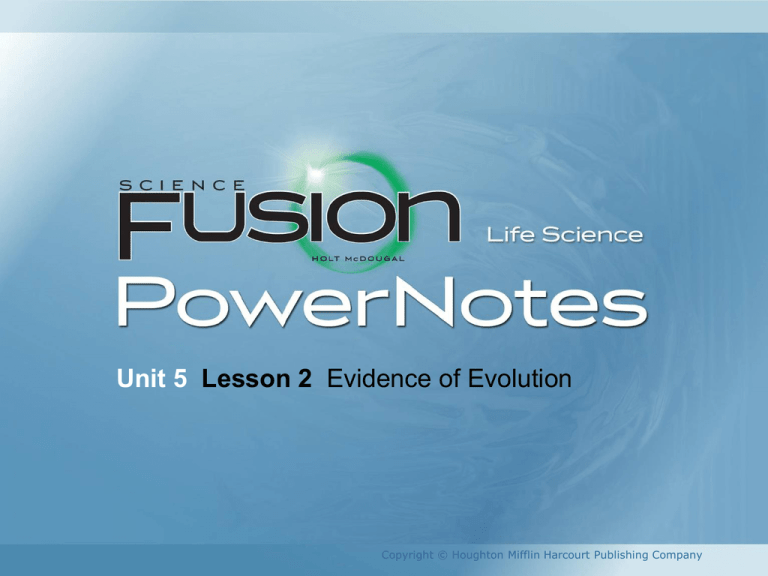6-1_CFLAEAS493558_U05L02
advertisement

Unit 5 Lesson 2 Evidence of Evolution Copyright © Houghton Mifflin Harcourt Publishing Company Unit 5 Lesson 2 Evidence of Evolution Florida Benchmarks • SC.7.N.1.5 Describe the methods used in the pursuit of a scientific explanation as seen in different fields of science such as biology, geology, and physics. • SC.7.L.15.1 Recognize that fossil evidence is consistent with the scientific theory of evolution that living things evolved from earlier species. Copyright © Houghton Mifflin Harcourt Publishing Company Unit 5 Lesson 2 Evidence of Evolution Fossil Hunt How do fossils form? • Evidence that organisms have changed over time can be found in amber, ice, or sedimentary rock. • The most basic principle of dating rocks and the remains of organism is “the deeper it is, the older it is.” Copyright © Houghton Mifflin Harcourt Publishing Company Unit 5 Lesson 2 Evidence of Evolution How do fossils form? • Many fossils form in sedimentary rock. • Fossils are the remains or imprints of once-living organisms. • Fossils form when a dead organism is covered by a layer of sediment or mud. Over time, more sediment settles on top of the organism. • Minerals in the sediment replace the body’s material, and the minerals harden over time. Copyright © Houghton Mifflin Harcourt Publishing Company Unit 5 Lesson 2 Evidence of Evolution How do fossils show change over time? • All of the fossils that have been discovered make up the fossil record. • By examining the fossil record, scientists learn about the history of life on Earth. • There are gaps in the fossil record in which a fossil has not been discovered. Copyright © Houghton Mifflin Harcourt Publishing Company Unit 5 Lesson 2 Evidence of Evolution How do fossils show change over time? • Fossils that help fill in gaps in the fossil record are called transitional fossils. Copyright © Houghton Mifflin Harcourt Publishing Company Unit 5 Lesson 2 Evidence of Evolution How do fossils show change over time? • Fossils found in newer layers of Earth’s crust tend to have physical or molecular similarities to present-day organisms. • Fossils from older layers are less similar to present-day organisms. Copyright © Houghton Mifflin Harcourt Publishing Company Unit 5 Lesson 2 Evidence of Evolution More clues … What other evidence supports evolution? • Many fields of study support evidence that modern species and extinct species share an ancestor. • A common ancestor is the most recent species from which two different species have evolved. • Structural data, DNA, developmental patterns, and fossils all support the theory that populations change over time. Copyright © Houghton Mifflin Harcourt Publishing Company Unit 5 Lesson 2 Evidence of Evolution What other evidence supports evolution? • Related organisms share structural traits. Copyright © Houghton Mifflin Harcourt Publishing Company Unit 5 Lesson 2 Evidence of Evolution What other evidence supports evolution? • Scientists can compare the DNA from many organisms. • Similar genetic information stored in DNA gives evidence that two species most likely share a common ancestor. • If organisms develop in similar ways as embryos, it is likely that they share a common ancestor. The study of development is called embryology. Copyright © Houghton Mifflin Harcourt Publishing Company Unit 5 Lesson 2 Evidence of Evolution How do we know organisms are related? • Fossils give evidence for how certain species changed gradually over time. • Fossils and DNA evidence support the hypothesis that modern whales evolved from hoofed mammals that lived on land. • Scientists have examined transitional characters of extinct species to see how changes happened. Copyright © Houghton Mifflin Harcourt Publishing Company Unit 5 Lesson 2 Evidence of Evolution How do we know organisms are related? • The skeletons of fossils suggest how a land mammal might have gradually changed to an aquatic whale. Copyright © Houghton Mifflin Harcourt Publishing Company Unit 5 Lesson 2 Evidence of Evolution What other evidence supports evolution? • Molecular evidence also shows that the DNA of whales and hoofed mammals is very similar. Copyright © Houghton Mifflin Harcourt Publishing Company









